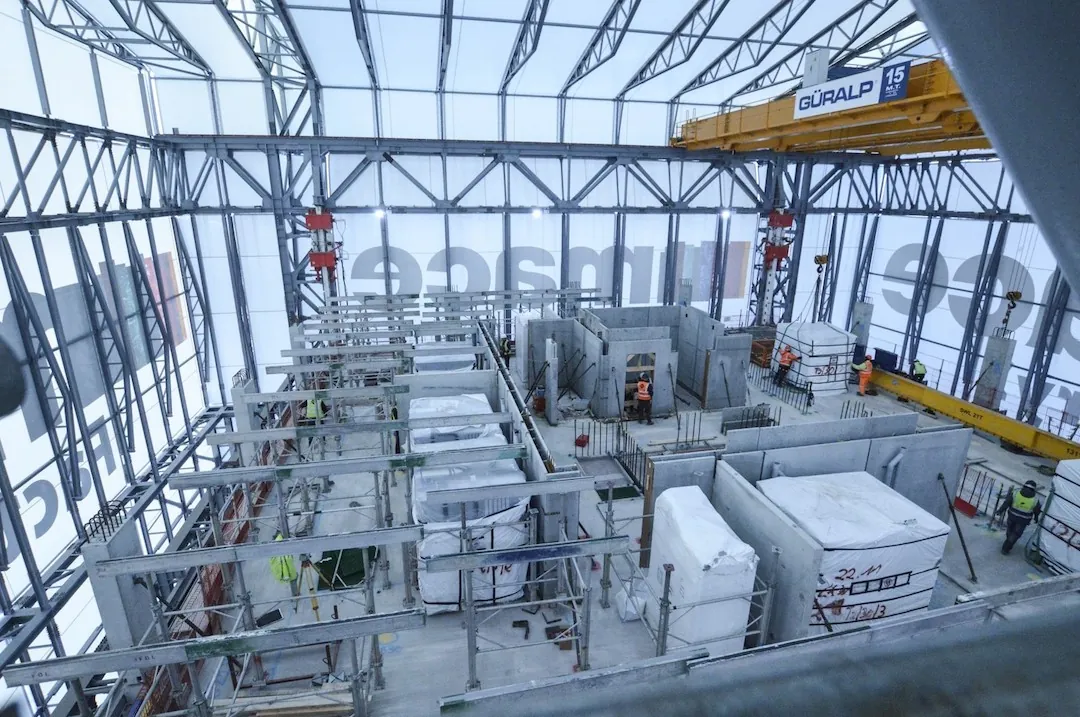To mark the launch of our new Activity page, we’ll be writing and sharing content that delves deeper into our investment thesis. We are kicking off this series by revisiting and updating one of the first trends we identified as a tectonic shift in the future of the built environment, the concept of Constructuring.

It’s May 2020. At the time I am writing this, much of the world has slowed to a halt and has been ordered (or at least requested) to stay at home. Construction in many places has been stalled either by government mandate or by supply chain disruption. The glass and steel towers of commercial real estate and the behemoth sporting and concert venues sit unoccupied while hospitals exceed capacity. It is certainly a time for pause and reflection, whether chosen or forced.
At Building Ventures, many team Zooms have been spent discussing and revisiting our mission, our investment thesis and our predictions for the futures of industries we invest in given the state of the world. These discussions along with thoughtful conversations across our portfolio and network led us to the decision to put fingers to keyboard to share current takes on our core theses. Overall, we are pleased to report that our core belief that technological innovation will transform the entire built environment lifecycle remains unchanged and perhaps more of an imperative now than ever. We are kicking off this series by revisiting and updating one of the first trends we identified as a tectonic shift in the future of the built environment, the concept of Constructuring.
First, for readers who might be less familiar with BV…
Building Ventures backs the founders leveraging technological innovation to advance the ways in which we design, build, operate and experience the built environment. We think of the built environment as a holistic system requiring technology to improve each phase of a building’s (or infrastructure’s) lifecycle. Construction technology impacts how we more effectively, safely and resiliently design and build. Real estate technology, aka PropTech, enables us to operate buildings more efficiently and sustainably, and, ultimately, provide a better experience for those who live, work or play in these spaces. Hence, we view the construction and real estate industries as a continuum and the technologies that support their respective advancements as complementary.
Let’s focus on the first half of that lifecycle: the ways in which we design and build today. It is no secret that many problems plague the construction industry, and stale processes and a reluctance (and sometimes inability) to embrace tech have given it the earned reputation of an antiquated industry. According to McKinsey, Construction is the 2nd LEAST digitized industry in the world (just slightly better than Agriculture for the curious). It is no secret that large projects typically take 20 percent longer to finish than scheduled and are up to 80 percent over budget. And the reasons and results are manifest: failures to scale, slow speeds, high costs, poor quality of work, tremendous amounts of waste and pollution, jobsite safety issues and operations that disrupt life all around it. Combine these issues with an ever growing labor shortage, and you have an industry in critical need of change.
Conversely, let’s consider manufacturing, an industry that is similar in its employment of tradespeople, operation of machinery and purpose in transforming materials into more complex products. Yet this industry is characterized by efficiency, reducing costs, consistent output, safe and healthy working conditions contained to a facility and (somewhat better) efforts to reduce waste and pollutants. It is also associated with adoption, even creation, of autonomous processes and tech.
1.
https://www.mckinsey.com/industries/capital-projects-and-infrastructure/our-insights/imagining-constructions-digital-future
We believe that if architects, engineers and general contractors in the construction industry embrace many of the same principles of manufacturing they can solve the aforementioned issues and usher in a new era of Constructuring that will meet the demands of our times.
So why hasn’t change been embraced, and why are we betting on it now? Construction HAS made some advancements, of course, but these have not been enough to keep up with our rapidly growing population and unrelenting urbanization. And the need grows more urgent by the day with an expected 2.5 billion MORE people expected to live in urban areas over the next 30 years. Even with advancements made in steel and concrete construction, innovations in the production of aluminum and glass façade cladding systems, the adoption of building information modelling (BIM) and project management software, conventional construction cannot achieve the speed and scale required to meet the demands. In an interview at the 2017 Techonomy Conference, Autodesk’s CEO quantified the challenge we face as: “We literally have to build 1,000 buildings a day over the next 33 years” so that by 2050 we can accommodate the world’s population of 10 billion people. He went on to say that “In the developed world, cities are not able to provide the capacity for this population. In the developing world, there’s simply not enough roads and bridges to provide capabilities for these people to have the mobility they need”.
A quick point of comparison and clarification. The concept of Constructuring is a repeatable, scalable, end-to-end solution, as is manufacturing. Compare this to conventional construction methods where every project is treated as a one-off. Design begins from a blank page, schedules and budgets are unforecastable and workers are exposed to the elements and unsafe site conditions. The definition of unpredictability. Unbelievers and naysayers, would read this and protest that we are advocating merely for prefabrication and modular construction techniques only capable of producing cookie cutter results and questionable business models. That is not the extent of opportunity inherent in Constructuring. Sometimes the opportunity for improved safety or efficiency will be found on a factory floor and sometimes in the open air of the jobsite. We are advocating for and envisioning a system that enables the adoption of any number of impactful technologies that can be applied throughout its phases and processes. For example, leveraging the computational power of the cloud will enable generative design to create optimally performing and visually compelling buildings beyond the limits of our imagination.
I’m an unrelenting optimist but also a pragmatist. Human beings are maddeningly slow to take action when problems seem obtuse and innocuous in their daily lives. Sadly, climate change is a perfect example of this lack of urgency to change behaviors. The methods and means of how we design and build are another terribly apt example. When BV first embraced the trend of Constructuring as a pillar in our investment thesis, it was mainly because we believed that due to the global urbanization demands cited above colliding with a massive labor shortage the industry
2
https://www.un.org/development/desa/en/news/population/2018-revision-of-world-urbanization-prospects.html
would be forced to embrace technologies like robotics and processes like modular simply to get the job done. We also felt assured that cities and corporations were leading the charge in forcing positive sustainability and resiliency, and we bet that this trend would continue and become a real forcing factor alongside productivity requirements.
What we did not see coming was COVID-19. The trappings of this new reality have closed offices, stores, restaurants and jobsites alike. While many answers remain unknown, we can be certain that the problems the industry faced prior to this global health crisis not only still exist but require solutions more urgently than ever. The most critical hurdles to getting back to the jobsite and back to building include worker safety and site security. Workers will need to keep at safe distances and still be able to accomplish their tasks. Visibility into and oversight safe practices will be more critical than ever. As an example, we believe that adoption of technology for reality capture, worker and equipment tracking and site safety monitoring will transition from “nice to have” to “must have” overnight. This new forcing factor – the ability to safely work at all and under the watchful eye of trades, municipalities and states – is the strongest yet.
We need to get back to work building, and we need to keep workers safe – not just during social distancing, but always. Jobsites must be enabled and empowered, rather than dangerous and disruptive to the very cities they endeavor to build up. Constructuring is the future of the industry. Well before our current global health crisis, we collected evidence and placed bets on startups that reflected this trend. Check out Blokable, Built Robotics, Hypar, Join and Smartvid.io to learn more about the movement already underway.
Note: This post is intended to give you some background and an update on our team’s belief in the Constructuring trend. My opinions have been strongly influenced by (and I borrowed liberally from) “Constructuring: An Unstoppable Trend” written on BV’s behalf by the inimitable Ian Howell. Ian is a member of the Building Ventures Innovators Network, a Limited Partner in the Built Environment Innovation Fund, the former CEO of Newforma and a mentor to many of us across the industry. There are many more insights to glean on the disruptive impact Constructuring can have on the future of the built environment in his full whitepaper. I highly recommend reading it here.


